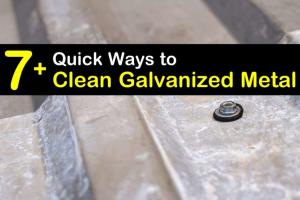Ultimate Guide to Cleaning Galvanized Steel: Tips & Techniques for Longevity

-
Quick Links:
- 1. Introduction
- 2. Understanding Galvanized Steel
- 3. Importance of Cleaning Galvanized Steel
- 4. Preparation for Cleaning
- 5. Cleaning Methods
- 6. Post-Cleaning Care
- 7. Case Studies
- 8. Expert Insights
- 9. Conclusion
- 10. FAQs
1. Introduction
Galvanized steel is a popular material known for its durability and resistance to rust and corrosion. However, like any material, it requires periodic cleaning and maintenance to preserve its appearance and functionality. In this comprehensive guide, we will explore the best practices for cleaning galvanized steel, ensuring its longevity and aesthetic appeal.
2. Understanding Galvanized Steel
Galvanized steel is steel that has been coated with zinc to prevent corrosion. The galvanization process involves immersing the steel in molten zinc, resulting in a protective layer that enhances durability. This makes galvanized steel ideal for outdoor applications like fencing, roofing, and equipment.
3. Importance of Cleaning Galvanized Steel
Cleaning galvanized steel is crucial for several reasons:
- Prevention of Rust: While galvanized steel is resistant to rust, dirt, grime, and moisture can lead to corrosion over time.
- Aesthetic Appeal: Regular cleaning helps maintain the shiny, attractive appearance of galvanized surfaces.
- Longevity: Proper maintenance extends the life of the galvanized steel, saving costs on replacements.
4. Preparation for Cleaning
Before you begin cleaning galvanized steel, it is essential to prepare adequately:
- Gather Supplies: You will need a soft-bristle brush, mild detergent, water, and a clean cloth or sponge.
- Choose a Suitable Location: If possible, clean the galvanized steel in a shaded area to prevent the cleaning solution from drying too quickly.
- Wear Protective Gear: Use gloves to protect your hands and safety goggles to shield your eyes from splashes.
5. Cleaning Methods
5.1 Basic Cleaning
For routine maintenance, a simple cleaning method will suffice:
- Mix a solution of mild detergent and warm water.
- Using a soft-bristle brush or sponge, apply the solution to the surface.
- Gently scrub the surface to remove dirt and grime.
- Rinse thoroughly with clean water.
- Dry with a clean cloth to prevent water spots.
5.2 Deep Cleaning
For galvanized steel that has not been cleaned in a while, a deep cleaning may be necessary:
- Prepare a mixture of vinegar and baking soda to create a paste.
- Apply the paste to tough stains and allow it to sit for 10-15 minutes.
- Scrub with a soft brush, focusing on stained areas.
- Rinse thoroughly with clean water and dry off.
5.3 Rust Removal
If rust has formed on galvanized steel, it is crucial to address it promptly:
- Use a wire brush or sandpaper to gently scrape off the rust.
- Apply a rust-inhibiting primer once the rust is removed.
- Follow up with repainting or re-coating with zinc if necessary.
6. Post-Cleaning Care
After cleaning, it’s important to maintain the galvanized steel:
- Inspect for any signs of rust or damage.
- Apply a protective coating if necessary.
- Regularly check and clean to prevent build-up of dirt and grime.
7. Case Studies
Consider the example of a community park that utilized galvanized steel fences. Over five years, regular cleaning and maintenance led to minimal rusting and extended the fence's lifespan significantly, showcasing the importance of proper care.
8. Expert Insights
Experts recommend scheduling cleaning sessions at least once a year, especially in areas with high humidity or pollution. They also suggest using eco-friendly cleaning solutions whenever possible to protect the environment.
9. Conclusion
Cleaning galvanized steel is a straightforward process that can significantly enhance its durability and appearance. By following the methods outlined in this guide, you can ensure your galvanized steel remains in excellent condition for years to come.
10. FAQs
1. How often should I clean galvanized steel?
It is recommended to clean galvanized steel at least once a year, or more frequently if exposed to harsh environmental conditions.
2. Can I use bleach to clean galvanized steel?
No, bleach can cause damage to the zinc coating and lead to corrosion. Stick to mild detergents instead.
3. Is it safe to pressure wash galvanized steel?
Pressure washing can be effective but use a lower pressure setting to avoid damaging the surface.
4. What should I do if I notice rust on my galvanized steel?
Remove the rust with a wire brush and apply a rust-inhibiting primer or recoat with zinc if necessary.
5. Can I paint galvanized steel?
Yes, but ensure the surface is clean and use a primer designed for galvanized surfaces to ensure adhesion.
6. What cleaning products are safe for galvanized steel?
Use mild detergents, vinegar, and baking soda to clean galvanized steel safely.
7. How do I prevent future rust on galvanized steel?
Regular cleaning and applying protective coatings can help prevent rust from forming.
8. Can I use a wire brush to clean galvanized steel?
Yes, a soft wire brush can be used, particularly for rust removal, but avoid aggressive scrubbing that could damage the zinc coating.
9. What is the best way to store galvanized steel?
Store in a dry place and avoid contact with moisture to prevent corrosion.
10. Is it necessary to wear gloves when cleaning galvanized steel?
Yes, wearing gloves protects your hands from cleaning solutions and any sharp edges.
Random Reads
- Create calculator in cplusplus
- Create burn cd macos x
- How to clean mold off ceiling
- How to clean laptop compressed air
- How to solve parallel circuits
- Change comma to dot excel
- Change default gmail account
- How to add subtitles to windows media player
- How to add url to bing
- How to grow wheat in minecraft